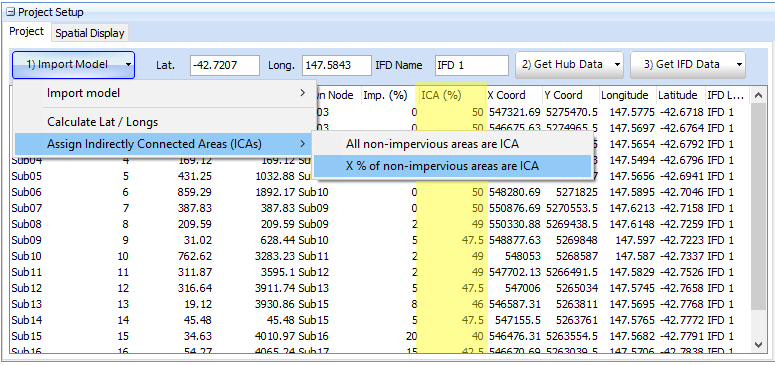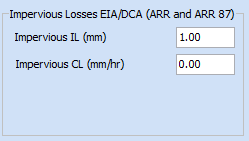
Storm Injector Help
Book 5 Chapter 3.4 outlines how losses should be calculated in urbanised catchments. It identifies that urban catchments may comprise Directly Connected Areas (or Effective Impervious Area), Indirectly Connected Areas (ICAs) and Pervious Areas and each may have different loss rates. From version 1.1.7, Storm Injector can support different loss rates for each of these categories.
Designation of Indirectly connected Areas
Storm Injector has 3 options for designating ICAs, specifically

These work in the following way.
•No Indirectly Connected Areas (ICAs) (default)
Storm Injector will operate by default with pervious loss rates and impervious loss rates and the values set for ICAs Burst Losses will not be used.
•All non impervious areas are ICAs
All non impervious areas are assumed to be ICAs and will be applied ICA burst initial and continuing loss values.
•ICA % assigned for each subarea in Project Setup
The user can manually fill in the % ICA in the Project Setup panel.
If the third option is selected, then the individual percent ICA should be entered in the Project Setup panel in ICA (%) column. This can be done for each row, multiple rows at a time (group select and right click) or there are also options in the drop menu associated with the 1) Import Model button to automatically assign ICA proportions based on some simple criteria.

Storm Injector allows the loss rates for each type of surface to be specified as outlined the following sections. However, since most Australian hydrologic models do not support specific loss rates for ICAs, Storm Injector will create weighted averages of the ICA loss rates and the pervious loss rates and will inject these into the model for the non-impervious component of each subcatchment. Note that identifying ICA percentages for subcatchments (or using the 'All non impervious areas are ICAs' option does not effect the impervious percentage used in the model and is only used in the calculation of loss rates.
Note that the RORB engine available to Storm Injector (1.31) does not support different loss rates for every subcatchment (this is done via Interstational Areas) and thus the 3rd option can not be used with RORB.
Pervious (rural) Losses
There are a number of options for burst initial loss rates for pervious areas. These include conversion of calibrated loss rates to burst losses, Probability Neutral Burst Losses (for NSW) or global initial loss minus pre-burst depths as well as other methods.

The pervious continuing loss rate is typically obtained from the Data Hub download but it can be overridden in the Override Pervious Losses section. There is also a link to a webpage where FFA reconcilled losses for various catchments can be viewed.

Impervious Losses
Impervious loss rates can be set in the Impervious Losses section. It should be noted that only XP-RAFTS supports a non-zero Impervious continuing loss rate and presently RORB and URBS do not support an impervious initial loss via Storm Injector.

Indirectly Connected Area Losses
The burst losses for the ICAs are set in the following section. There are 3 options for the initial loss:
• A set percentage of initial loss minus pre-burst depths
•A specific percentage of the pervious burst loss; or,
•A specific value.

The first option may be appropriate if you are using initial loss minus pre-burst for your pervious burst losses and the second option may be better if you are using a non pre-burst pervious loss rate method such as Probability Neutral Burst Losses or a Calibrated Loss.
The ICA continuing loss is a specific value set by the user. However, this should not be accepted blindly and should be reviewed in the context of the pervious continuing loss from the Data Hub or the value being used to override the Data Hub value (refer the Override Pervious Losses section).
